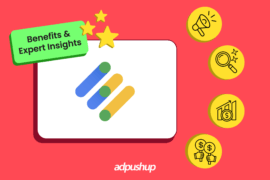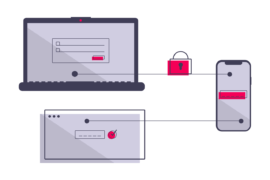How do you think Google chooses the right buyer for your inventory based on type, ad size, and deal for the impressions? The answer is using line items.
If you are a part of ad tech, then you must have heard this term being thrown around a lot. Some of you must be closely working with various line items on a daily basis.
But do you understand exactly what line items are? And what makes it so special for the ad industry. In this post, we are looking to answer all the questions around GAM line items and priorities.
What Are Line Items in Google Ad Manager
Line items are used to define inventory to sell it more logically. Where the creative will display (ad units targeted). How many times will it appear (number or percentage of impressions/clicks). Who will see it (targeting criteria), and so on.
Suppose you (publisher) get a purchase request from a buyer. Then this request will come in form of ‘Order’. This order should have one or more line items. Inside the line item, you can actually see the requirements of the buyer. Starting with, whether buyer wants a guaranteed deal or a bulk buying (decided based on assigned priority). Then you can see requirements from ad sizes and inventory quantity to targeting.
Ad Manager Line Item Types and Priorities
Line item type and priority are a starting point to determine how a line item competes with other line items, yield groups, and Ad Exchange for impressions. Line item type and priority are only one factor of many in ad selection.
Google Ad Manager
It defines the course of action for the inventory selected under a specific type/priority.
For instance, the common logic suggests that premium inventory should have higher priority than remnant inventory. And line item priority helps with the same.
Here are the line item types, listed from highest to lowest priority:
| Type | Priority |
| Sponsorship | 4 |
| Standard (high) | 6 |
| Standard (normal) | 8 |
| Standard (low) | 10 |
| Ad Exchange | 12 |
| AdSense | 12 |
| Network | 12 |
| Bulk | 12 |
| Price Priority | 12 |
| House | 16 |
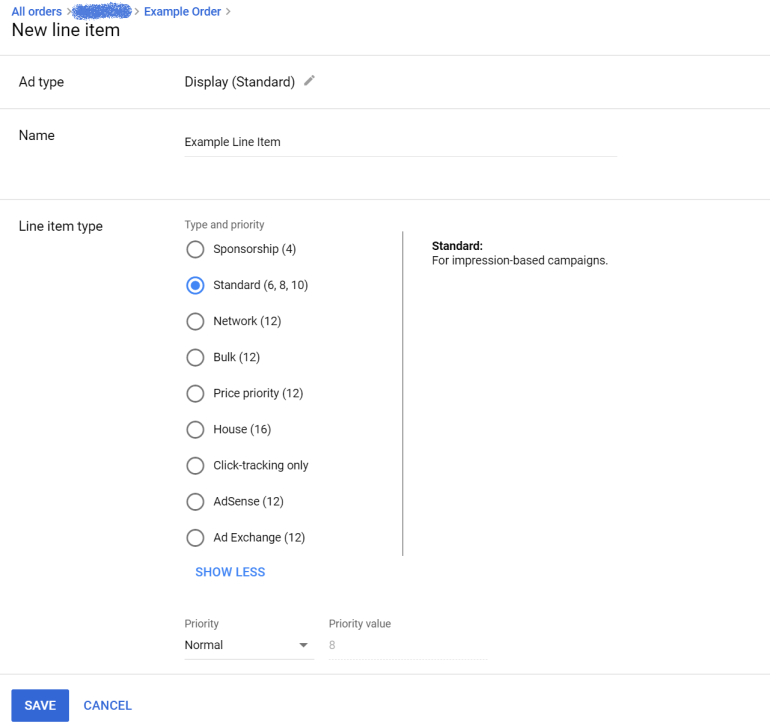
So How Does Line Item Actually Work?
When a user launches a webpage, the browser sends content and ad requests to the server. In case of ad request, the server (Google Ad Manager) stores the details of the webpage inventory — ad location, size, user’s first-party data (if allowed), time zone, targeting details and more.
Ad Manager, then goes through all the line items to see which one (or more) matches the ad request generated by the webpage. When the eligible line items are found, Ad Manager sort them based on priority. Meaning, line item with highest priority gets to run for the webpage and added buyers get the request for the user impression.
(For line items with equal priority (Ad Network, Bulk, and Price Priority), GAM focuses on time out and highest bid. Basically, the highest bidder within stipulated time wins the impression.)
Guaranteed Line Items
You’re contractually obliged to deliver on these, and the system makes sure that you do. There are two of these.
1. Sponsorship
Sponsorship line items are high priority and served based on percentage assigned to them. Basically, if two line line items are to be served for a part of inventory, then these might have 50% sharing goal. Similarly, in case of three line items, the share could be 50%, 25%, and 25%.
This is the reason, this type of advertising also called ‘share of voice’, because advertisers would certainly get a share of impressions with sponsorship line items.
Here competition is determined by the percentage share not the price.
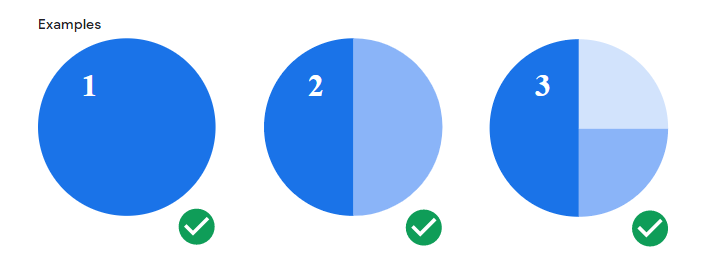
- Exclusive sponsorship: One line item booked for 100% of the matching ad requests.
- Competing sponsorship: Two line items, each would serve to 50% of the matching ad requests.
- Multiple competing sponsorship: Multiple line items, each serving assigned percentage share of matching ad requests.
What if the percentage sum is more than 100?
Let’s understand this with an example: line_item_A has 75% share and line_item_B has 50% share, then the cumulative share becomes (75 + 50) 125%. In such a case,
line_item_A will reassign the share as (75/125) 60%
And line_item_B as (50/125) 40%
Some particulars to go by:
- Sponsorship is time-based and sold on the basis of impressions (CPM), days (CPD), or clicks (CPC).
- Can use all available targeting criteria. Only the impressions that match all the targeting are counted in delivery.
- Requires defined flight time (start and end dates)
- Typically used for direct-sold roadblock deals.
2. Standard
Standard line items are high-priority and served based on quantity goals (impressions).
For instance, a standard line item can be set up targeting a particular ad unit (leaderboard) for a certain number of impressions (200K) during a fixed time (month of March).
Unlike sponsorships, standard line items can compete against remnant line items based on price. Meaning, if Ad Manager finds another line item matching the ad request with a better price, then the standard line item can be beaten by ad network and non-guaranteed line items.
Some particulars about this line item type:
- Standard line items are sold on the basis of impressions (CPM)
- Used for directly sold campaigns.
- Has three priority types – High (6), Normal (8), and Low (10). On priority alone, Standard-High serves before Standard-Normal or Low.
Ad Network and Exchange Line Items
Using this line item, Ad Manager allows users to add AdSense and Ad Exchange accounts, managed under GAM.
AdSense: Add one or more AdSense accounts, create line items, and serve ads via AdSense for matched ad requests.
Ad Exchange: Add Ad Exchange and fetch demand to compete for the impressions on remnant inventory.
The ad network and exchange line item allows adding preferred deals to Ad Manager. The preferred deal time item has a fixed priority ensuring it wins over other open auctions except Sponsorship and Standard line items.
This is how priority works in the case of preferred deal:
- Sponsorship and Standard line item serves before preferred deal
- And preferred deal serves before Price priority, Network, and Bulk line items, including third-party line items set to ‘House’.
Non-Guaranteed (Remnant) Line Items
The impressions that are not eligible for the Sponsorship and Standard line items goes to remnant. Next, if AdSense and Ad Exchange are not eligible to compete, the priority sequence follows network, bulk, price priority, and bulk.
Simply put, if you wish to offer guaranteed impressions to advertisers, use Sponsorship and Standard. If you wish to prioritize certain advertisers over other non-guaranteed line items, use Preferred deal. And for the rest of remnant impressions, go for non-guaranteed line items.
Here is how you can use these line items based on your goals:
3. Network
Network line items are used to traffic your networks and allocate a specific percentage of remnant impressions.
For percentage-based, non-guaranteed goals, use Network line items. A specified percentage of impressions that remain after Sponsorship and/or Standard line items have delivered should go to Network line items.
Some particulars you should keep in mind about the Network line item type:
- Sold on CPM, CPC, or CPD (per day) basis
- Can have an unlimited end date
- Not included in forecast results
- Eligible to compete directly with AdSense and Ad Exchange
Network line items have a variable called weight, which you can define to adjust how often you want that line item to compete against others in dynamic allocation. For instance, a network line item with 100% weight will always compete, while a network line item with 50% weight will compete about half the time.
4. Bulk
With bulk line item, you can deliver (remnant) impressions to a client who wants to advertise on your site and is willing to pay X for Y amount of impressions, but doesn’t care about the timeline in which they are to be delivered.
- Sold on CPM and CPC basis
- Can have an unlimited end date
- Not included in forecast results
- Eligible to compete directly with AdSense and Ad Exchange
Marketers sometimes buy remnant impressions to deplete the last of their advertising budgets, which gets them the eyeballs without the high costs of direct-sold deals. Bulk line items are used for lower priority deals.
Their pacing determines how often they compete against other remnant line items in dynamic allocation. For example, if a bulk line item is behind schedule, it has a higher probability to compete against other remnant line items.
5. Price Priority
With Price Priority, you can sell remnant inventory to the highest paying buyer. Basically, it competes basis on the rates (prices) offered by the buyers.
- Sold on CPM and CPC basis
- Can set caps to specify delivery based on day (or lifetime)
- Set to unlimited impressions and have unlimited end date
- Not included in forecast results
- Eligible to compete directly with AdSense and Ad Exchange
If you make it compete against AdSense and Ad Exchange, then it allows Ad Manager to choose line items based on price. Basically, even if a Price Priority line item has unlimited delivery enabled, AdSense and Ad Exchange have a chance to win the impression if any of these has buyers with higher CPM.
6. House
House line items have lowest priority. When no remnant line items (Network, Bulk, Price Priority, Open Auction, Ad Exchange) are available to serve, the impression goes to House line item.
Generally, this line item is used by publishers to promote in-house products and services. These line items are designed keeping revenue goals in mind.
Dynamic Allocation to Compete AdSense and Ad Exchange in GAM
By enabling dynamic allocation in GAM, you can make AdSense and Ad Exchange to compete with GAM line items, without compromising the performance of guaranteed deals.
Advantages of using dynamic allocation:
- Better competition and hence CPMs for each impression
- Google Ad Manager takes care of managing and syncing the data
- Allows to add frequency cap and delivery setting as per campaign goals
- Improves fill rate in case of remnant inventory
How to Create a Line Item in GAM?
Google Ad Manager makes it easy to create a line item without knowing much technical know-hows. However, remember that monitoring and optimizing these line items require (efficient) ad operation skills.
For the operational part, follow these steps to create line item in GAM:
- Sign in to Google Ad Manager.
- Go to Deliver > Order > New Order or click on name of existing Order.
- Click on Add line item / New line item.
- Select the ad type — Display (Image, HTML5, and more) or Video (Instream, overlay, and more).
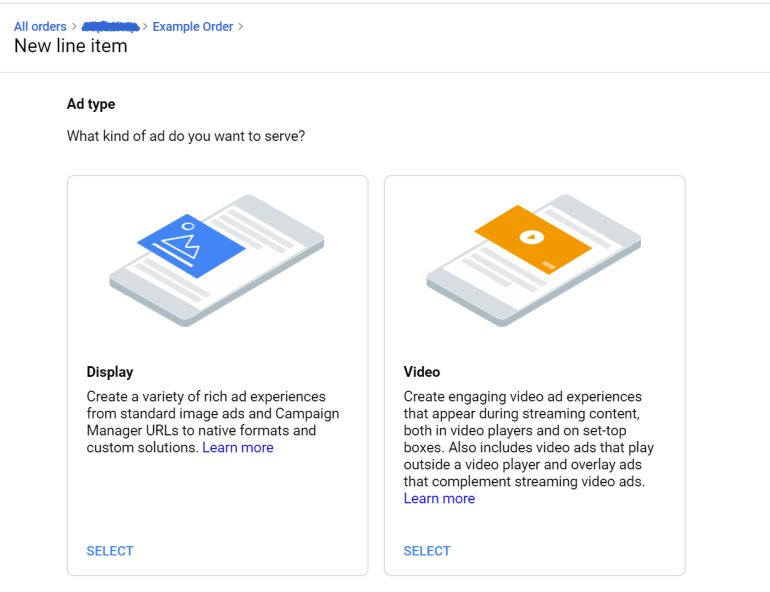
- Name the line item, make sure it is unique for this Order.
- Choose the line type and priority (as mentioned above).
- In the Expected Creative section, enter the ad sizes that you wish to allow for this line item.
- Other additional settings:
- Add ‘Labels’ to avoid showing line items from the same label on the same page.
- Allow same advertiser exception, this lets same advertiser show ads even when a competitive exclusion label is active.
- Also, you can add ‘Comments’ and ‘Custom Fields’ to help understand and recognize the line items in reports.
- Define the Delivery Settings as per your goals (common delivery settings discussed below).
- Click Save.
How Line Items Deliver
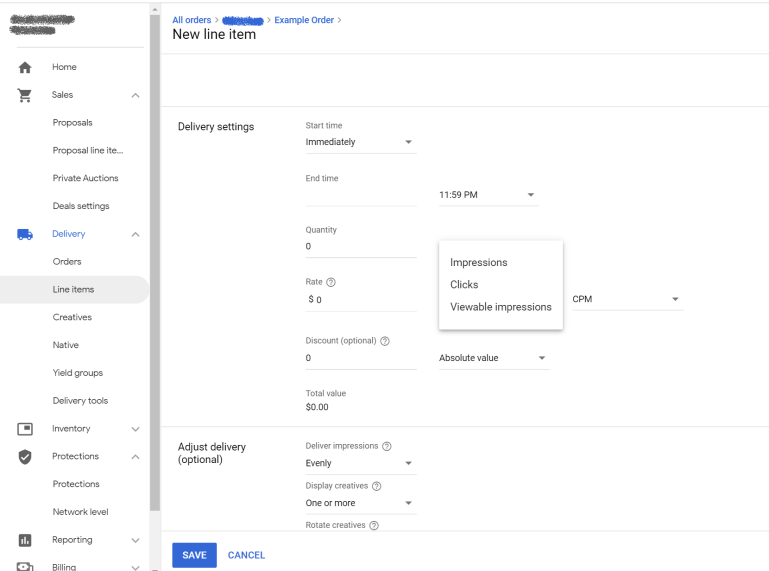
Delivery settings are there to configure the impressions delivery frequency.
- Deliver Impressions: Set the pace of a line item as Evenly (serves equal number/volume daily throughout the campaign runtime), Frontloaded (serve more impressions at the beginning of the campaign), or As fast as possible, which will block all lower priority or lower value line items from serving in the placements targeted by this line item until it reaches its goal.
- Display Creatives: Configure number of creatives associated with a line item displayed in the ad units on a page as Only One, One or More (shows multiple creatives per page for the same line item (if available)), or As Many as Possible (shows as many associated creatives for a single line item on a page as possible).
- Rotate Creatives: How many creatives will appear in a single unit, and for how long. By default, creatives with the highest CTR are shown more often. Can also be set to rotate Evenly, Weighted (at a specified frequency) or Sequentially (in a specified sequence).
- Day and Time or Dayparting: Run line items on specified days or hours. Run an hourly report to see when you receive traffic that matches high value line items’ targeting criteria.
- Frequency: Specify the number of times a user sees creative(s) from a line item. You can choose a maximum number of impressions per user and then set how often the cap will be reached by a line item. For instance, Set a Per User Frequency Cap so one user sees 5 impressions every 2 days from one line item. Multiple frequency caps can be stacked so the same line item doesn’t deliver creatives too often to the same user.
- Limit EEA Serving: There may be some line items that contain personalized targeting or whose creatives have vendor callouts that require user consent under Google’s updated EU User Consent Policy. In that case, you can choose which line items you want to serve to EEA users in personalized or non-personalized mode, and then work to obtain the necessary user consent.
Then there are targeting criteria – which let you specify where the ad will appear (inventory) and who will see it based on key-value pairs, geography, device, browser language, and more.
Since DFP has been re-branded as Google Ad Manager, Google has been making a few changes to the design and product (including line items) to make it more user friendly. It is recommended to keep yourself updated with latest updates to stay on the top of your game.
A growth blog for professional bloggers and ad ops professionals.



